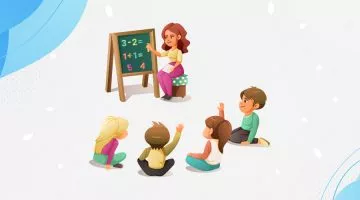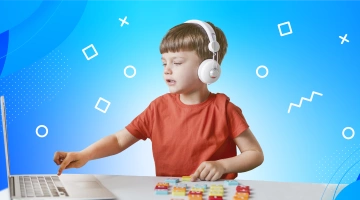30 Best Math Games for Kids: Online, Classroom, and Outdoor Fun
reviewed by Camille Ira B. Mendoza
Updated on January 23, 2025
Math requires high mental activity. It’s often the primary reason many children are reluctant to study this subject. But you can make learning funnier with dedicated math games and applications.
Keep reading to discover simple math games for kids for outdoor, in-class, and indoor implementation.
What are some fun math games?
Some fun math games & platforms to develop knowledge online:
- «Brighterly» is a math learning platform for kids with tutors offering customized learning plans with fun interactive activities and games for different grades – from grade 1 to 8;
1:1 Math Lessons
Want to raise a genius? Start
learning Math with Brighterly
 Let's start learning Math!
Let's start learning Math!
- «Monster Math» app for practicing math, includes basic practice of addition, subtraction, multiplication, division, and more.
Also, you shouldn’t forget about offline kids’ math games. Here are some popular ones that are useful as a fun math practice in class (you can suggest this to your child’s teachers):
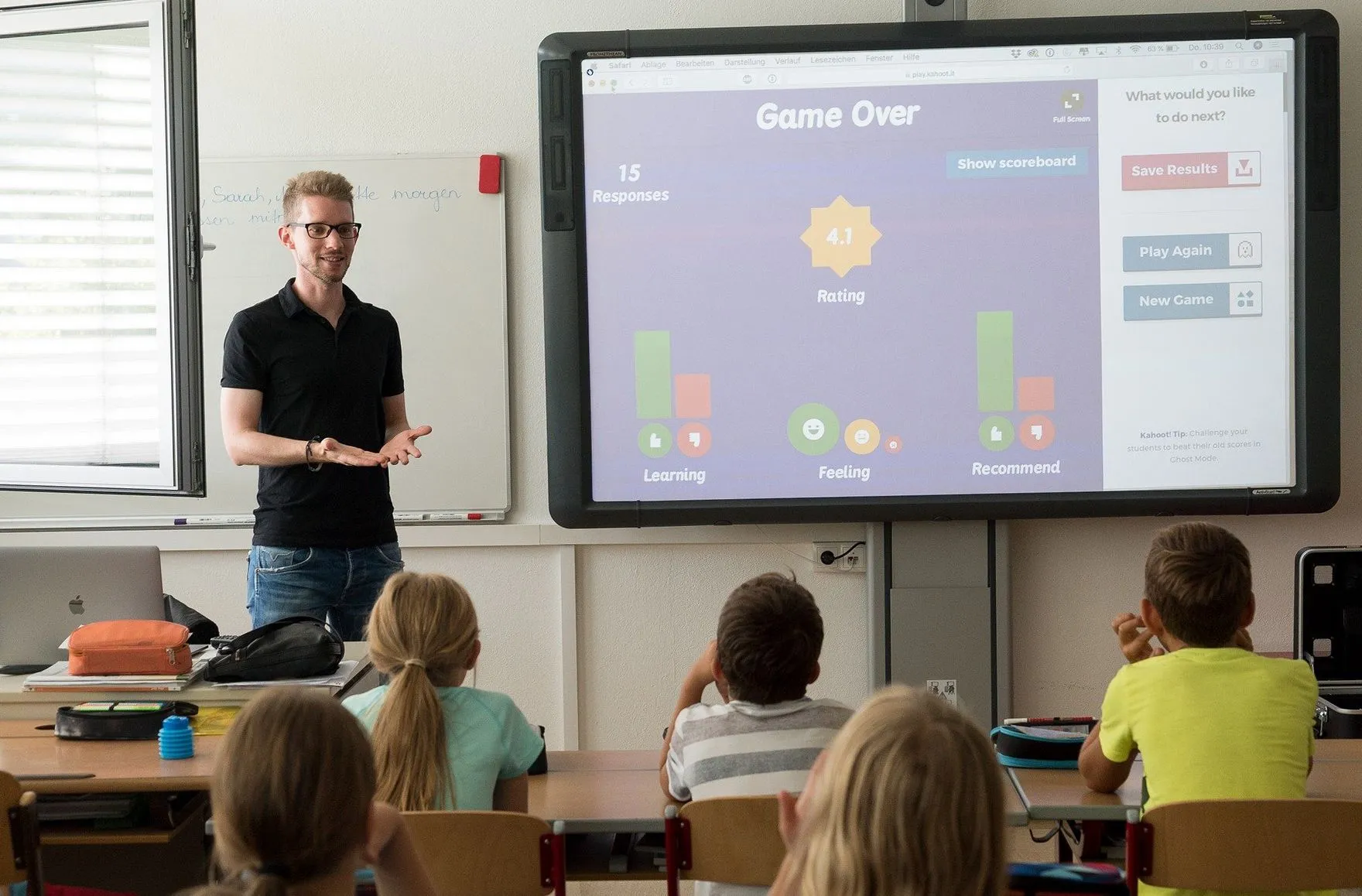
- «Tic-Tac-Toe» is a fun game for the whole class, very cool for developing strategic thinking in math and practicing addition skills;
- «Math Baseball» also for developing strategic thinking in math and practicing addition, subtraction, multiplication, and division.
Why are fun math games for kids good for learning math?
Fun math games for kids are good for learning math because they
- increase children’s interest in math
- reduce stress factors (eliminating the fear that math is «difficult and complex»)
- improve a child’s ability to concentrate
- improve math skills
- perceiving information faster
Impact of math game for kids: details
Increasing children’s interest via math game implementation
The interactive, playful format of presenting new math topics makes it clear to children that math can be fun and exciting.
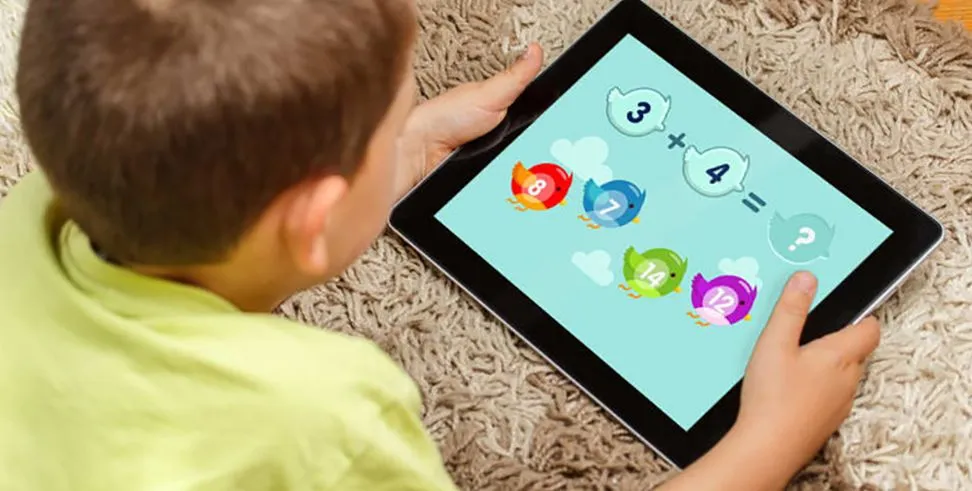
Today, we have more opportunities to diversify a math lesson with different unusual formats of presenting information. This benefits teachers, parents (at home when helping with homework), and tutors alike.
There is simply no chance to spoil a child’s impression of math anymore because there are so many incredible educational apps, websites, and math games to help your kid learn math.
In an interactive format, complex educational subjects are presented in a very easy and engaging way. Try explaining some math topics to your child in the play form. You’ll see how the stress factor changes in a short time from «I don’t understand it», to «Oh, it was so easy, thanks, Mom».
Remember. Online math games, explaining topics through presentations, team games, and math offline games – all of them stimulate a child’s curiosity, give them more confidence, create a pleasant learning experience, and encourage them to do their homework.
Improving concentration skills through a math game
What will the child focus all their attention on? On the explanation of a math topic when a teacher or parent monotonously reads a book or when the information is presented in a game format?
Obviously, the first format of presenting information will not leave the child in a moment of intense concentration. But if you include an interactive approach (for example, educational games) while doing homework with your child, you will definitely get a positive effect.
Of course, the full concentration of the child’s attention will be achieved after a while since children at different ages have various concentration times. All children are different, but in general, for example, kids from 5 to 6 years old can only focus for 12-18 minutes, children from 11 to 12 years to 35 minutes. It all depends on the age group and individual characteristics.
Your child’s attention span will increase over time with the right approach, taking into account their developmental stage and concentration ability. Soon, your kid will be able to focus on any topic with 90 to 100% concentration.
Even at school, if materials are presented in a boring format, a well-trained ability to concentrate will make it much easier for your child to sit still and understand the topic.
Improving math skills with math games
Math games teach numbers with fun. In essence, these are math exercises in unusual contexts that enhance children’s numeric fluency, mathematical reasoning, and logical thinking.
Math games for kids online can improve math skills depending on their specifications
| Math operations | addition, subtraction, multiplication, and division |
| Measurement units | weight, distance, speed, temperature, etc |
| Spatial skills | geometric shapes and figures |
Implementing math game = Broad math practice
Implementing math games is a broad math practice that targets many learning styles.
Children learn differently – some perceive textual information better, while others prefer explanatory visuals. Scientists call these differences in learning styles – visual, auditory, kinesthetic, and reading/writing.
Free online math games complement all learning styles:
- Visual – captivating animations and pictures
- Auditory – sound accompaniment
- Kinesthetic – game actions require mouse clicking and button pressing
- Reading/writing – textual information follows game actions
Types of math games for kids
- Classic math-based games
- Math games based on sports & physical activity
- Outdoor and adventure math games for kids
- Educational technology and apps
- Learning math through creative math game
- Math strategies and problem-solving
What are some games for children’s math skills?
- Brighterly
- Xtramath
- Monster Math
- SplashLearn: kids learning app
- Keiki Learning Games for kids
- DoddleMaths
- IXL
- DreamBox Learning
- ST Math
- Sumdog
- ABCmouse
And, of course, below you can find more about this top learning (only) paid hubs with captivating kids’ math games.
Brighterly
Type: educational technology and apps.
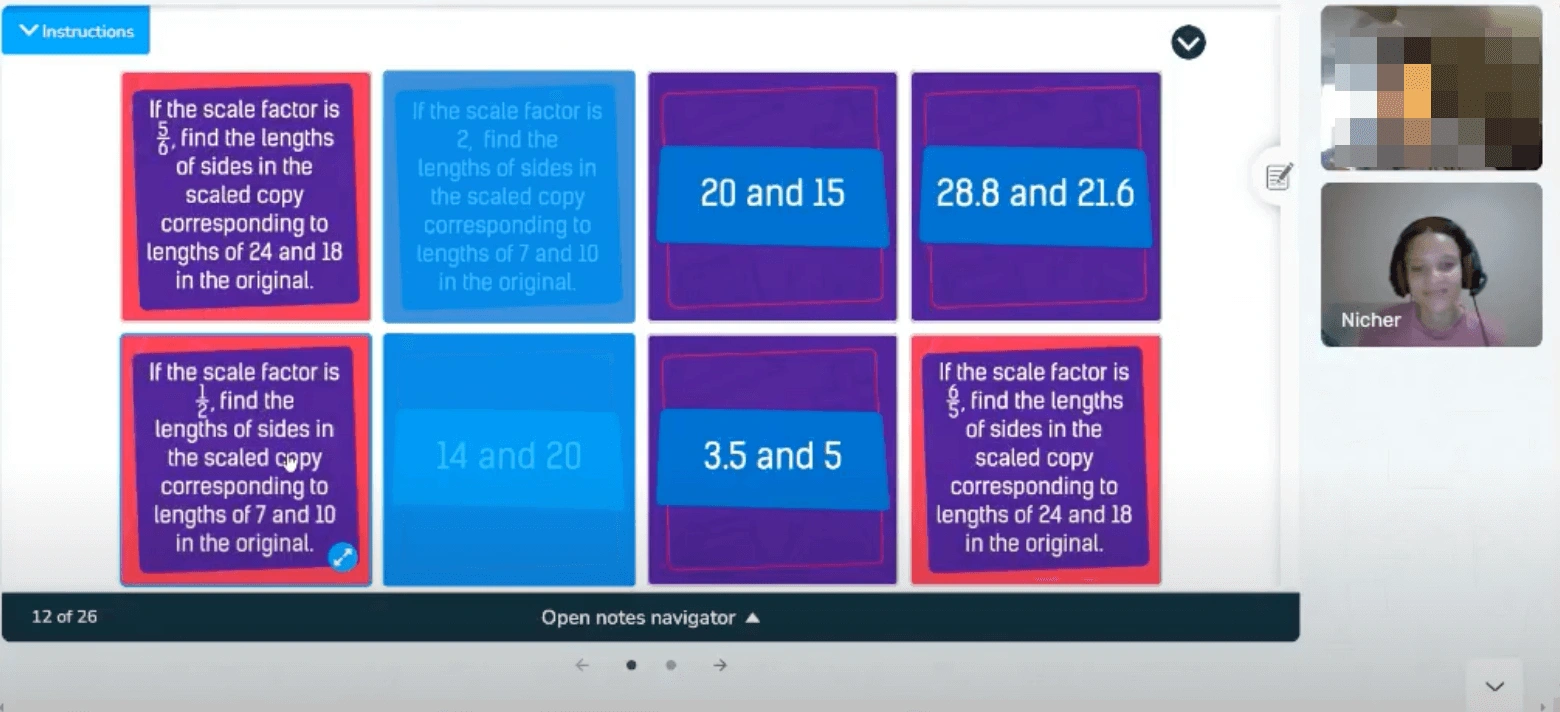
Brighterly is an educational platform for 1-8 students that offers play-based learning and gamification of math studying. At Brighterly, parents can enroll kids in 1-to-1 math classes with top math tutors in a few easy steps.
How can Brighterly help your child with learning math?
- Play-based math classes. Brighterly applies play-based teaching approaches to make math studying a more enjoyable experience:
- Interactive math games for kids with tutors.
- Math puzzles, riddles, and quizzes.
- Developmental STEM activities.
- Math tutors at Brighterly integrate these activities into play lessons within the courses that are accompanied by regular theory and assessment classes.
- Math Printables. At Brighterly, you can download free printable math worksheets for Pre-K to 8th-grade students. These learning materials contain fun math puzzles that complement a positive learning experience.
Price:
From $28/lesson. More details on Brighterly’s pricing plans page.
Xtramath
Type: educational technology and apps.
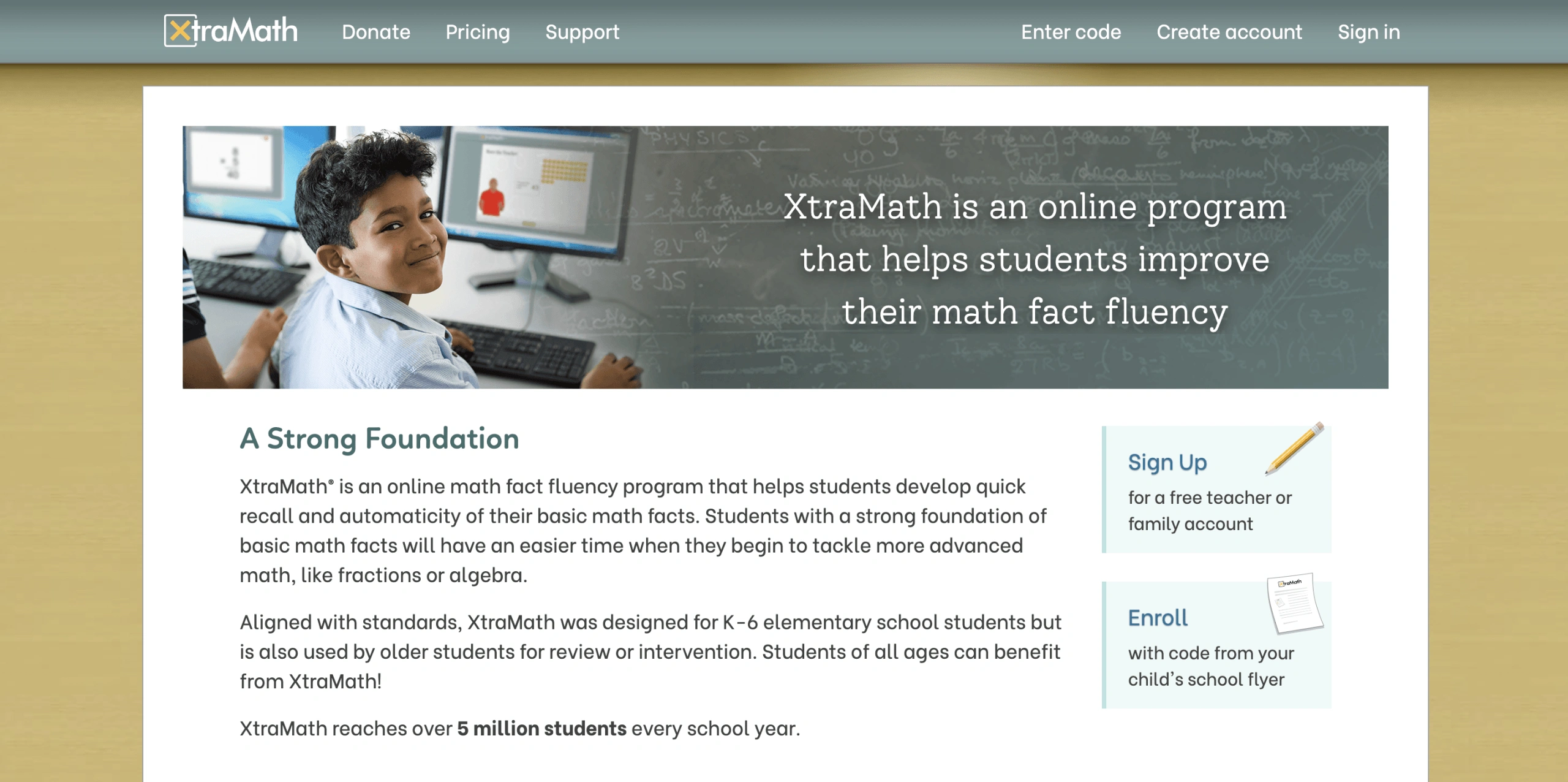
Xtramath is an online math program with educational math games that can enhance children’s understanding of math concepts.
How can Xtramath help your child with learning math?
- Xtramath is designed for homeschooling and group studying in the class. Teachers and parents should sign up on the platform to access educational content. Once you sign up, you can set up a teacher’s page and add students to the virtual classroom.
- The website provides math learning sessions and math games for kids online, for about ten minutes each. The session begins with an educational video that explains a math topic.
When the video finishes, students start solving math exercises. Upon completion, a student gets notified about their progress in the Fluency Matrix section. - Xtramath can become an addition to the homeschool math program or regular homework. As Xtramath developers suggest, their math sessions are great for using once a day as an extra math practice to recall studied topics and refine math skills.
Price:
Forever free plan available with access to a limited selection of student programs.
Paid PRO plans start from $2 per child per year and the number of student programs here is unlimited.
Monster Math
Type: educational technology and apps.
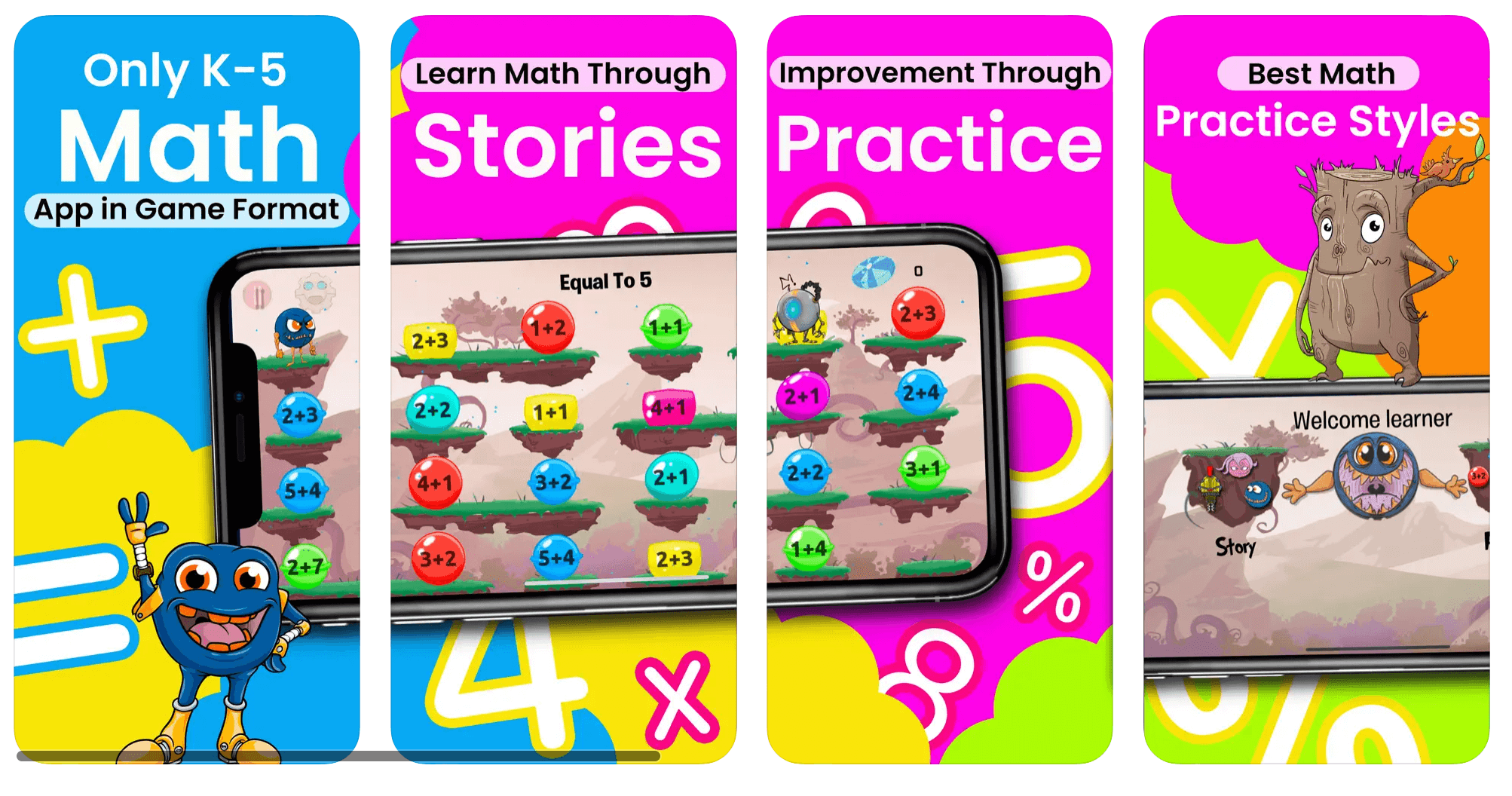
Monster Math is one of the top fun math interactive games designed to make math captivating for children regardless of their arithmetic proficiency. It suits the K-5 math curriculum.
Major features for your child that propose Monster Math:
- Cool math games for kids that teach core skills. The gameplay requires children to solve math equations to move their characters through game levels and kill monsters. You can customize the game difficulty to match your kid’s pace and knowledge.
- Multiplayer mode to develop your child’s teamwork skills. Monster Math is available in multiplayer mode, allowing you to compete with your children. Kids can also refine their math skills by competing against each other.
Price:
From $9,99 to unlock the full app version.
SplashLearn: kids learning app
Type: educational technology and apps.
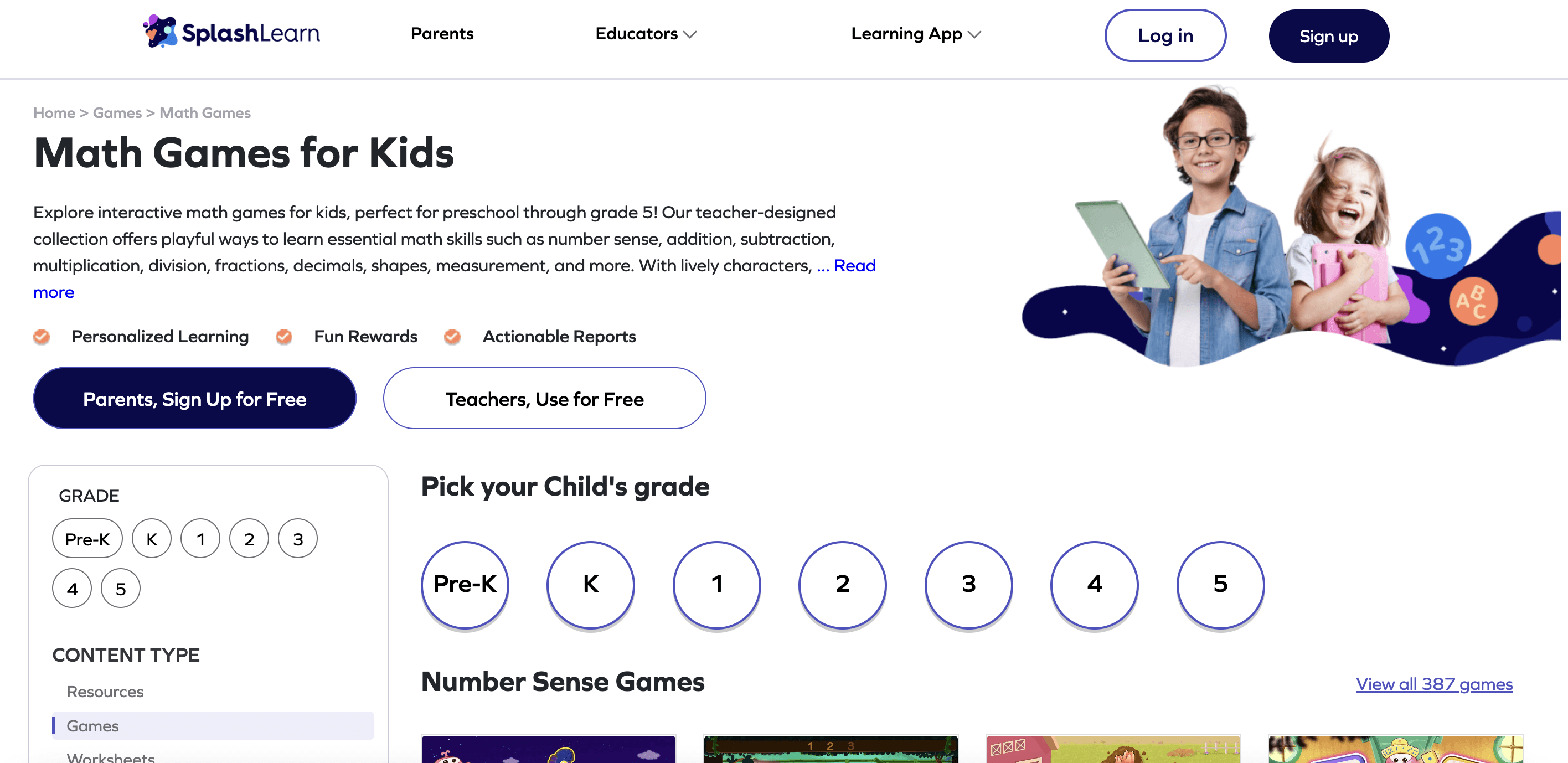
Splash Math is a collection of free math games for kids for the K-5 math curriculum available on Android and iOS devices. Check its features below:
Major features for your child that propose SplashLearn app:
- Free math games to Target Multiple Skills. Splash Math develops over 16 math skills, including fundamental arithmetic operations, money, measurements, unit conversions, place values, decimals, etc.
- The app offers thousands of free math games for kids that over 750,000 teachers use daily to strengthen math skills of over 4 million children.
- Math Worksheets. The application offers interactive math worksheets for K-5 students to complement math homework and games.
- Cross-platform availability. Splash Math is well-adapted to all screens and devices. Your child can play math games on iOS and Android devices, as well as Mac and Windows.
Price:
From $7.99 for membership monthly.
Keiki Learning Games for Kids
Type: educational technology and apps.
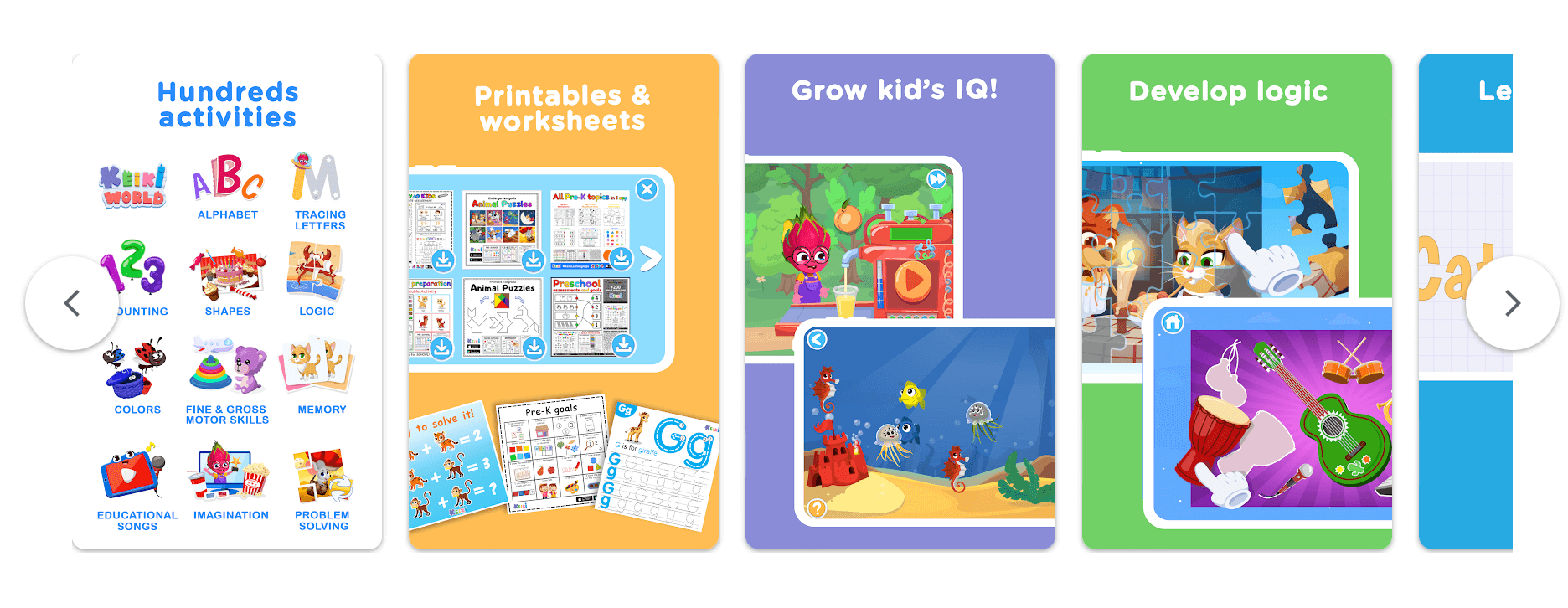
Keiki Learning Games for Kids is a collection of 200+ fun math games for kids available on Android and iOS devices.
Major features of Keiki Learning Games for Kids app:
- Educational games for preschool kids, puzzles for toddlers.
- The curricula in the app were developed by experts in the field of children’s education. That’s why kids spend their time in the app not only for fun but also profitably.
- Information in this app is presented in various formats that can be entertaining for children. For example, there are games with fun songs to learn numbers.
- The Learning Games for Kids app can help develop kids’ fundamental math skills – counting, number sense, geometric shapes, and basic measurements.
Price on math interactive games:
In-app purchases – €4.29 – €74.99 if billed through Play.
DoodleMaths
Type: educational technology and apps.
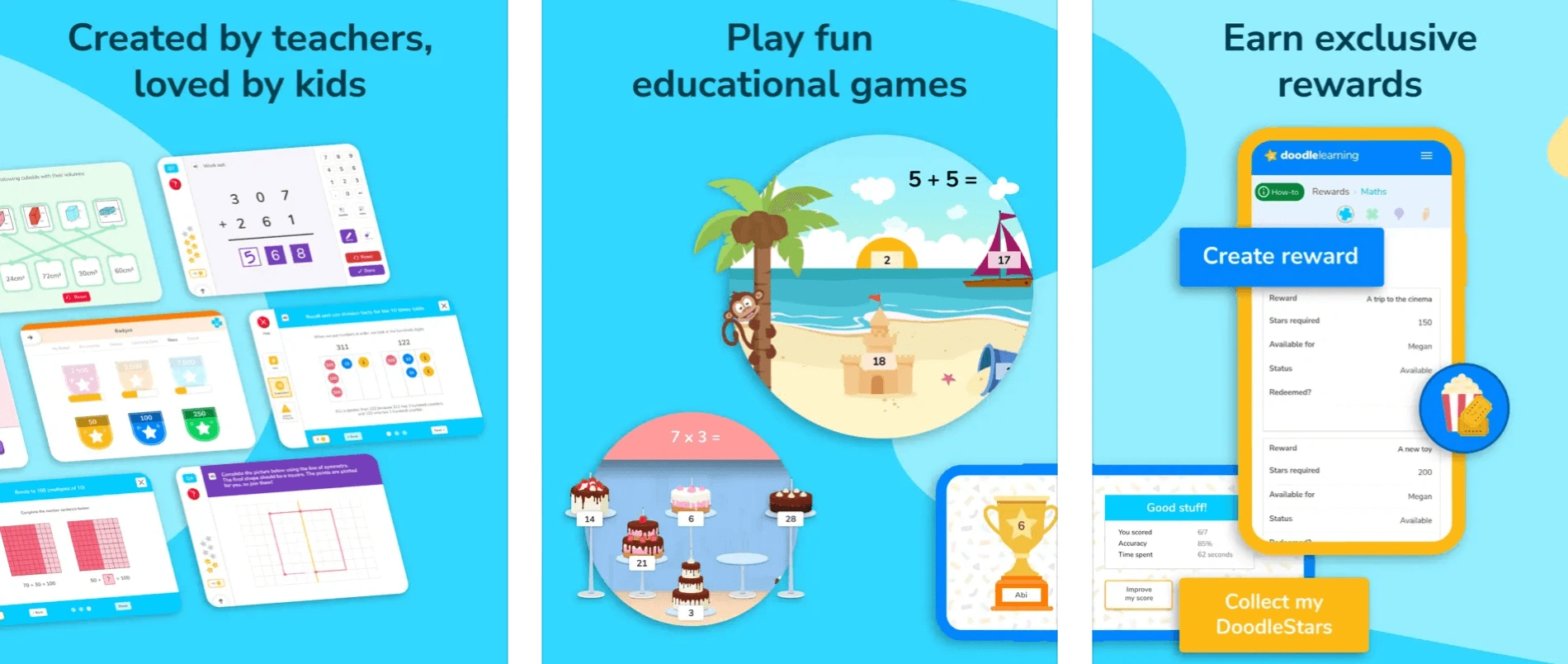
DoddleMaths is a math learning application for primary school. It’s available on iOS and Android devices.
Major features of DoodleMaths app:
- DoodleMaths features over 40,000 diverse math exercises.
- The app will suit homeschoolers and pupils attending public schools as an extra 10-minute-a-day brain workout.
- Your child can access fun math games online on their tablets and smartphones anytime and anywhere.
- DoodleMaths features customizable difficulty levels so that students of various math backgrounds can benefit from the app.
How Much Does DoodleMaths Cost?
You can purchase Doodle Maths games at as low as £7.99 per month. The family subscription supports up to five children and costs only £12.99 per month.
IXL
Type: educational technology and apps.
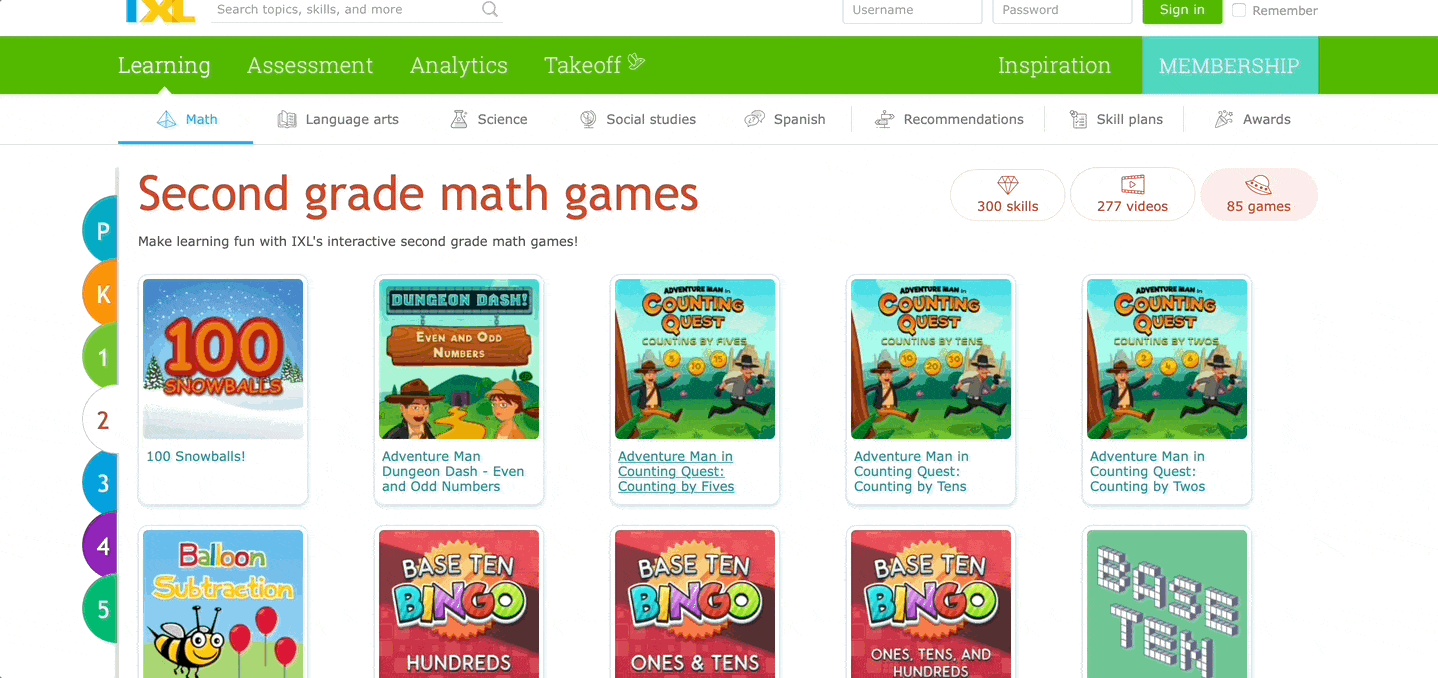
IXL offers personalized learning on over 8k topics in math and other academic subjects. There is a huge selection of fun math games online for preschoolers and schoolers from 1st to 5th grade.
Major features of IXL for kids:
- Learning for different groups of children is categorized.
- Each section contains a number of topics to study, tests, and math games.
- Educational videos are added to help children learn new topics more easily starting with the 2nd grade,
The 3rd grade unit includes videos, skills (tests), math learning games, and lessons. Here, kids can learn more complex topics and practice.
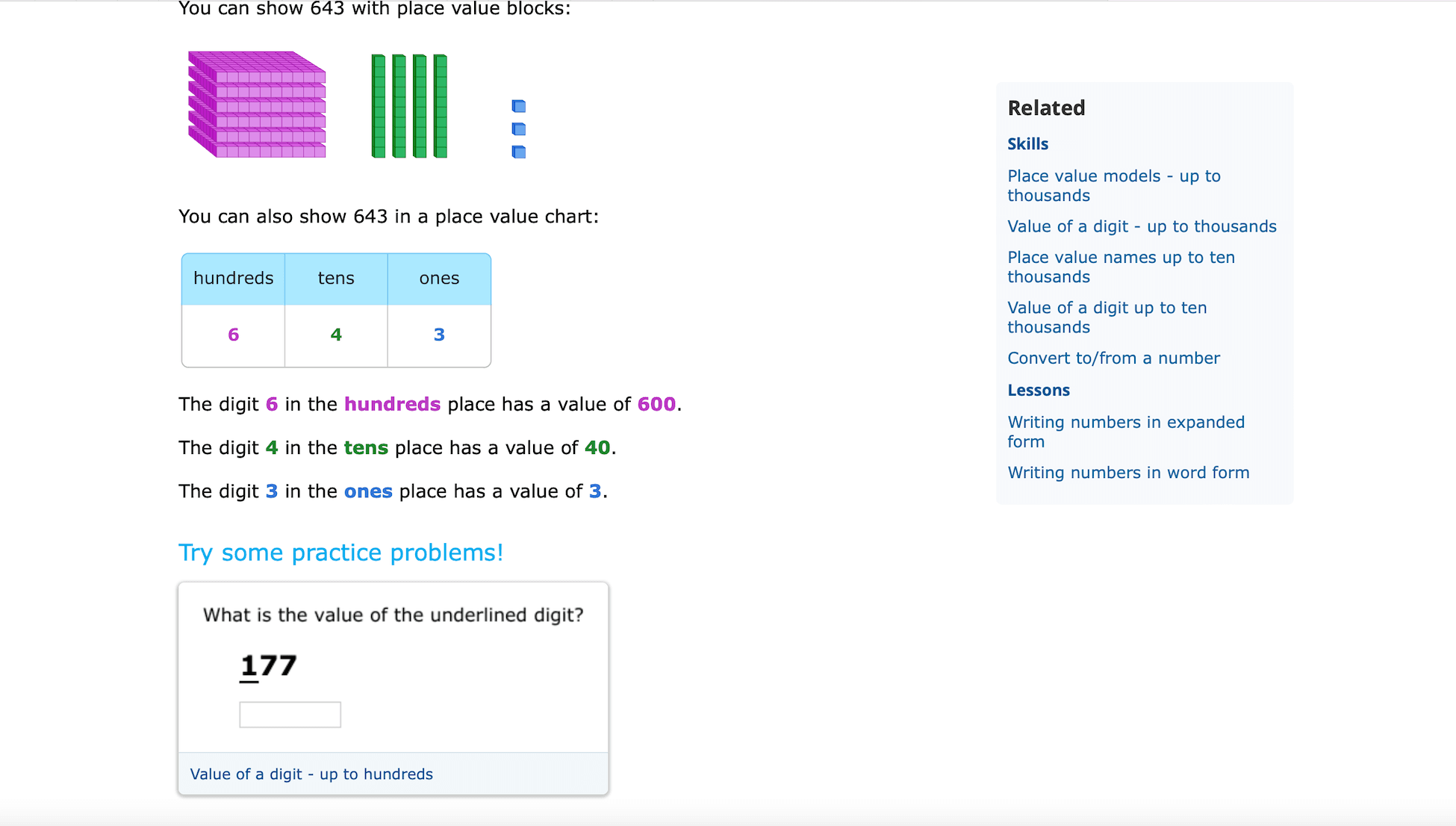
Price:
10 free questions per day in each subject area.
For unlimited practice choose a paid plan. Information about price upon request.
DreamBox Learning
Type: educational technology and apps.
DreamBox Learning is an interactive learning platform to help your child upgrade their math skills. DreamBox offers personalized learning journeys adapted to the individual needs of each kid.
Major features of the DreamBox platform for kids:
- Innovative approaches to teaching mathematics through best math games.
- Personalized math learning for children from preschool to 8th grade.
- The best for homeschooling, blended learning, or hybrid learning.
Price:
Upon request.
ST Math
Type: educational technology and apps.
ST Math uses interactive game puzzles to teach children math concepts. The platform uses its patented spatial-temporal approach with the visual basic math concepts teaching.
Major features of ST Math:
- ST Math games online include more than 30k puzzles with interactive presentations of all topics. All topics meet all state standards.
- The child must complete each level with a perfect score (100%) to move on to the next level. This allows the kid to achieve perfect results in each topic and excel in all math topics in the platform’s programs.
- There are programs for Early Learning, K-6, Middle School, Summer Immersion, etc.
- On the platform’s website, you can find free games for Pre-K to 8th grade. Below is an example of a game for counting to 7.
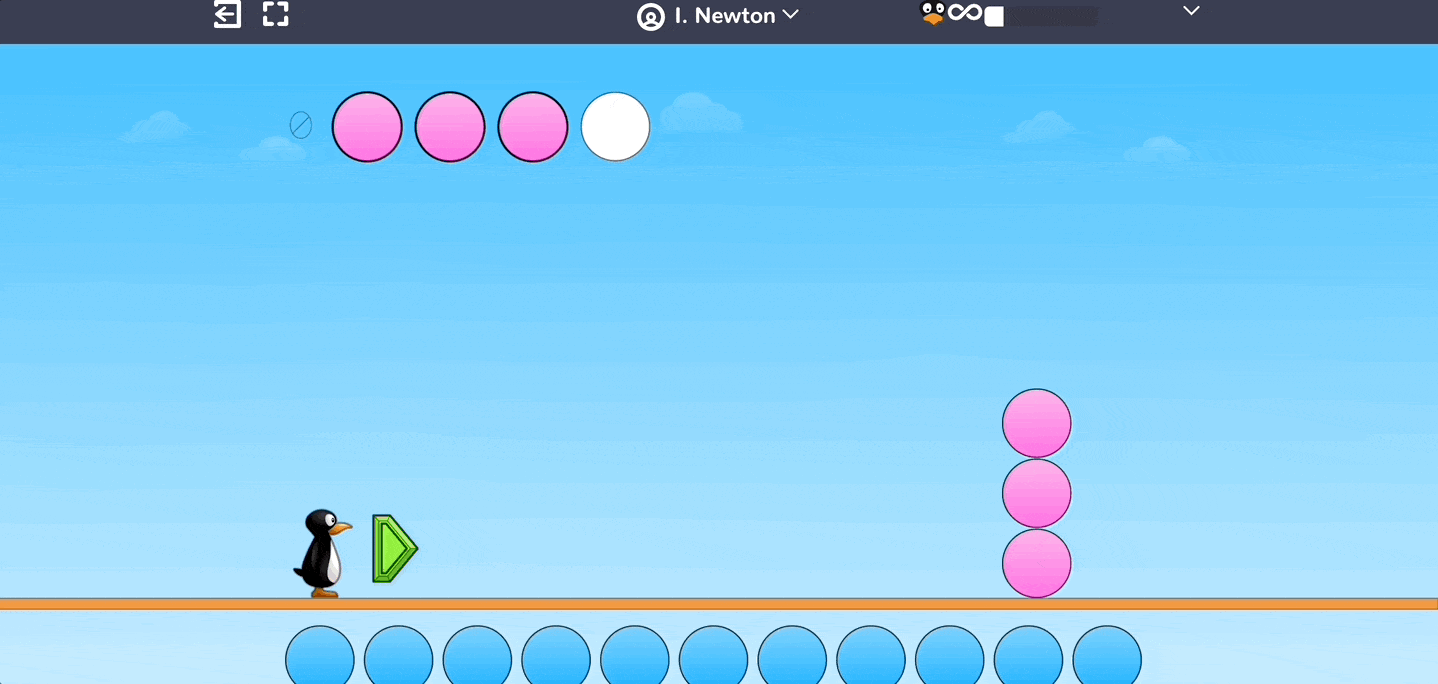
Price:
Upon request.
Sumdog
Type: learning math through a creative math game.
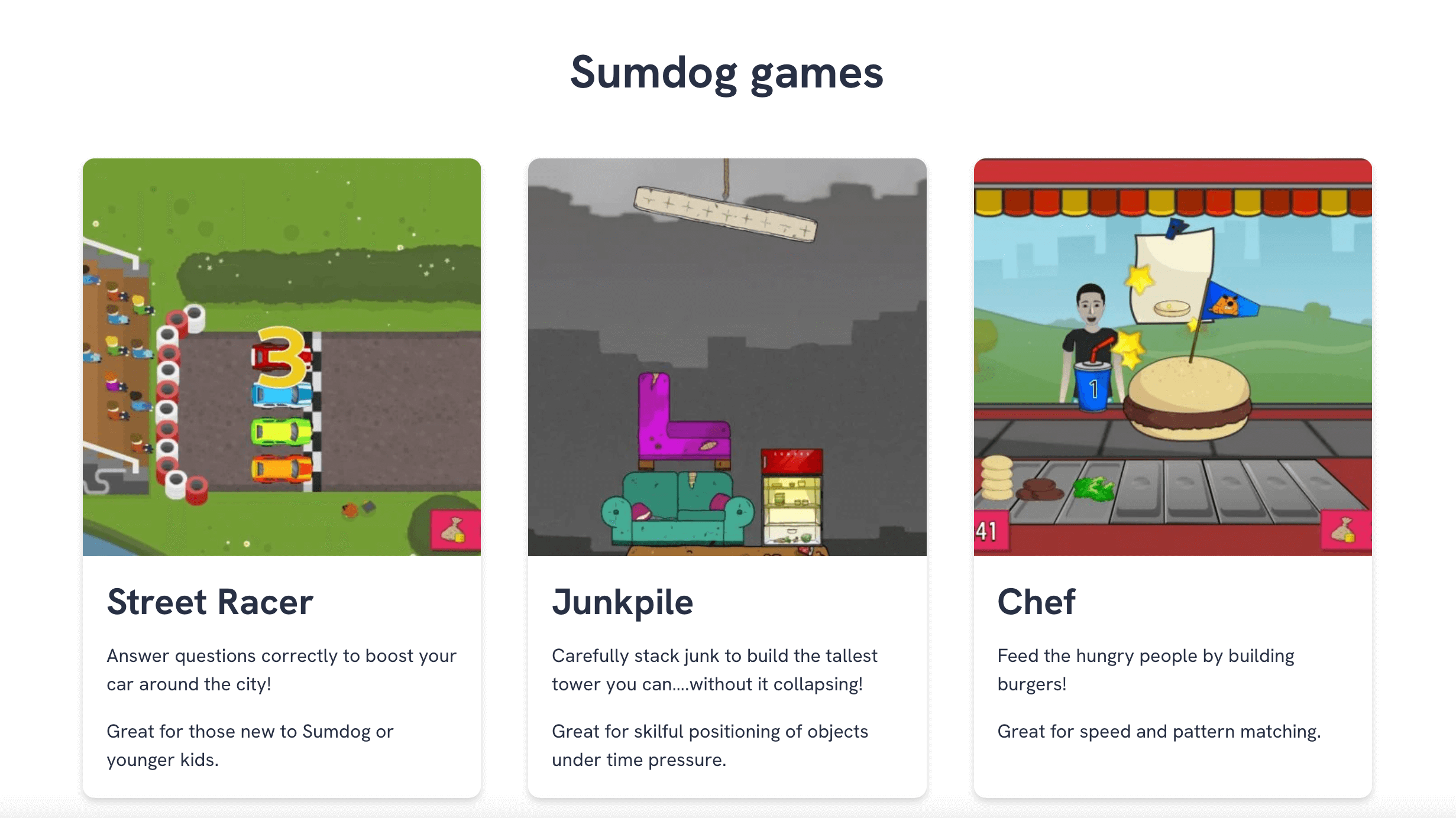
Sumdog is a website that offers math learning games according to a child’s level from 5 to 14 years old. Using gamification for learning makes it easy to convey complex information to kids, and to evoke positive emotions from learning the lesson and better information perception.
Major features of Sumdog:
- Math games on the Sumdog website are adapted to the individual level of each kid.
- Here, you can create a math practice for your child in a game format to cover several sections.
- You can monitor your kid’s progress using analytics.
Price:
30-day free trial period.
Standard pricing for 1 class for 12 months (Sumdog Math) – $195.
ABCmouse
Type: educational technology and apps.

ABCmouse is an educational platform for children that offers to expand knowledge in such areas as math, reading, music, etc. in a game format. It’s a good option for learning math in a fun format for children aged 2 to 8.
Major features of ABCmouse:
- ABCmouse offers more than 850 lessons and many math games and activities.
- The platform covers a wide range of math concepts, from basic counting to elementary geometry.
- All games and activities are aimed at practical usage and developing kids’ math skills.
Price:
Free for 30 days. After the free trial $12,99 per month.
What are some free online math games?
- Zearn
- Math Playground
- Pbskids
- Funbrain
- Moose Math
- Khan Academy
- Prodigy Math Game
- Cool Math Games
- ABCya
- Arcademics
More about these free hubs and applications for playing math games online below 👇
Zearn
Type: educational technology and apps.
Zearn offers a complete mathematics curriculum with game-based elements. This platform engages students to learn math and helps them understand all difficult topics from the academic program.
Major features of the Zearn platform:
- Zearn aligns with Common Core standards by providing structured math lessons through technology apps.
- The platform proposes a math curriculum with 400 hours of digital lessons free.
- With Zearn, kids can practice math exercises at home, with onscreen teachers, visual models, math learning games, etc.
- It can be used as a separate learning program for your child (as a supplement to the school program).
Note. This platform is free for individual teachers and parents. Zearn paid for schools and districts because this Zearn subscription has extra features.
Math Playground
Type: educational technology and apps.
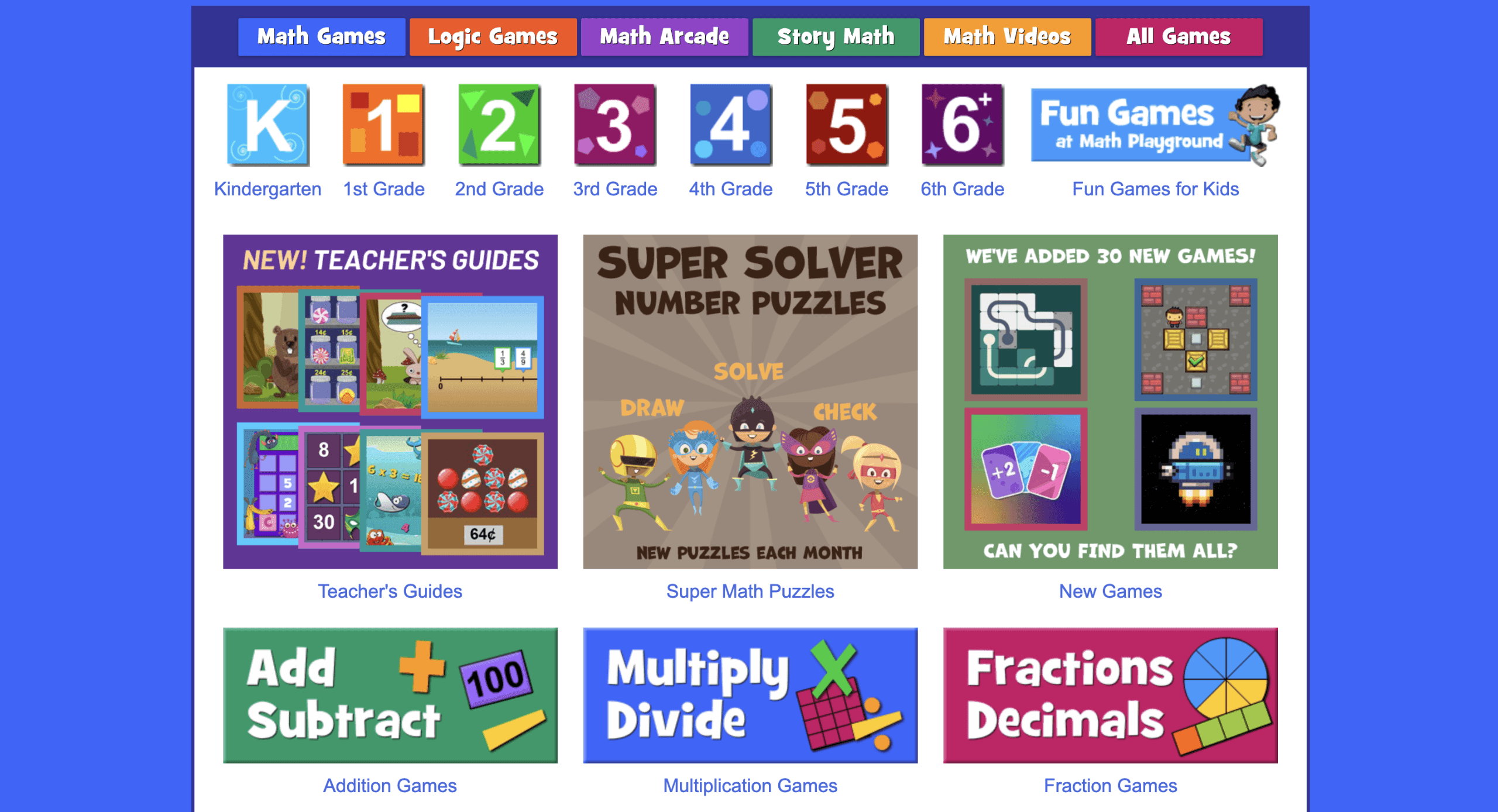
Math Playground is a collection of math games for toddlers from kindergarten, and kids from 1st to 6th grade. On the website, you can find a lot of math activities for your child like puzzles, educational videos, and printables.
Major features of the Math Playground platform:
- Math Playground features dozens of K-6 math facts games targeting the following topics: math operations and algebraic thinking, number operations in base ten, measurements, Geometry, Logic, and problem-solving, and Math word games.
- Children can play math games for free that center around particular topics – addition, division, measurements, math words, etc. Math Playground offers these games for K-6 students.
So, there is one more essential thing to know about Math Playground. Besides math learning games, your children can also enjoy worksheets, puzzles, and educational videos on math topics.
Pbskids
Type: learning math through creative play.
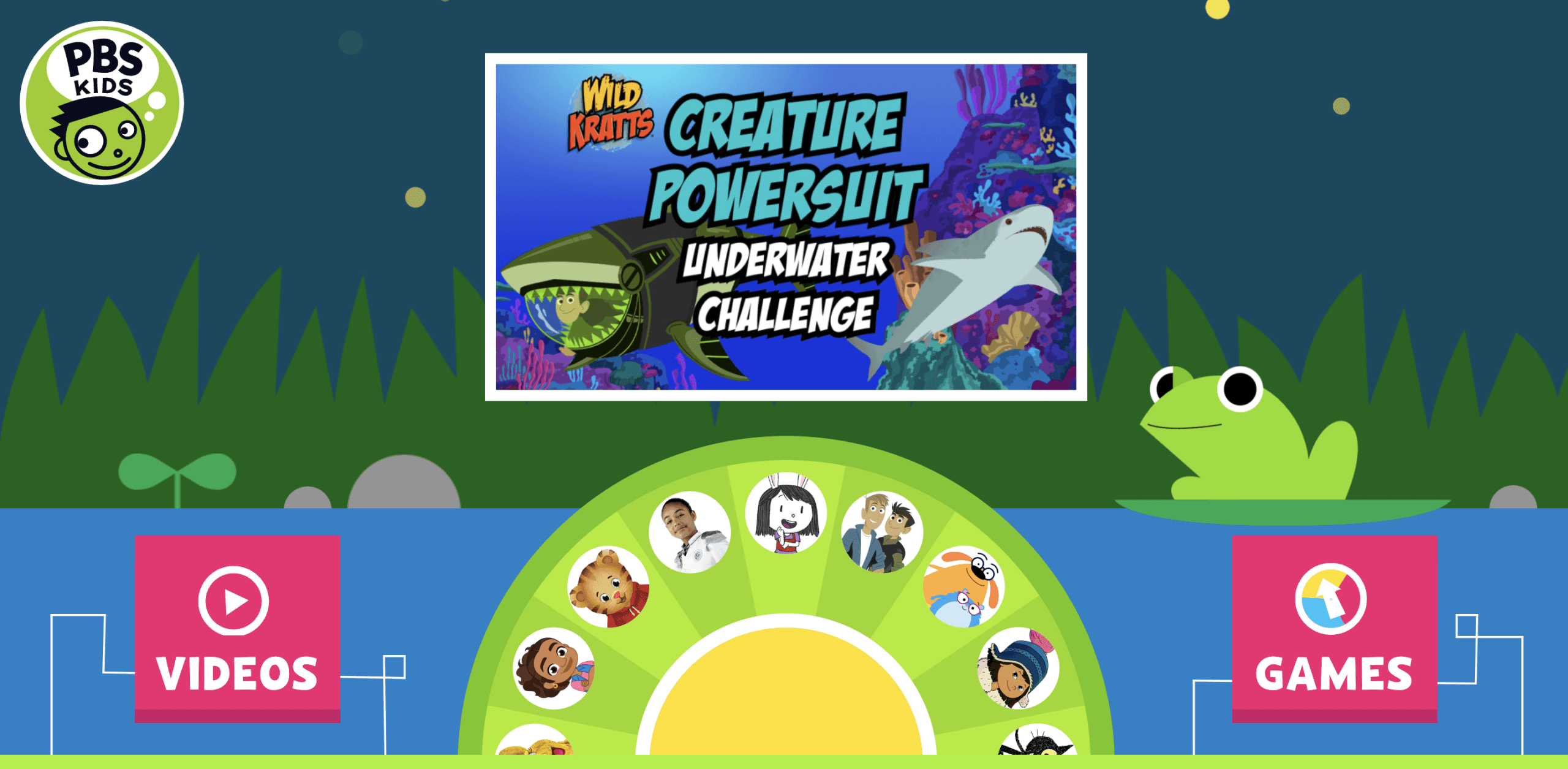
PBS Kids is one of the best on the list of math games for kids available for free.
This is an educational website that features animated free videos and games with cartoon characters.
Major features of PBS Kids:
- 80+ Fun Math Games. Your child can play over 80 fun animated educational games about math and nature. Children will solve math problems with animated TV characters to move through the gameplay.
- Educational Videos and Podcasts. Your child will access a collection of educational videos and podcasts about science, nature, math, logical thinking, and more.
Note. PBSkids adds new content regularly so children and parents can enjoy limitless learning opportunities.
Funbrain
Type: Classic math games for kids.
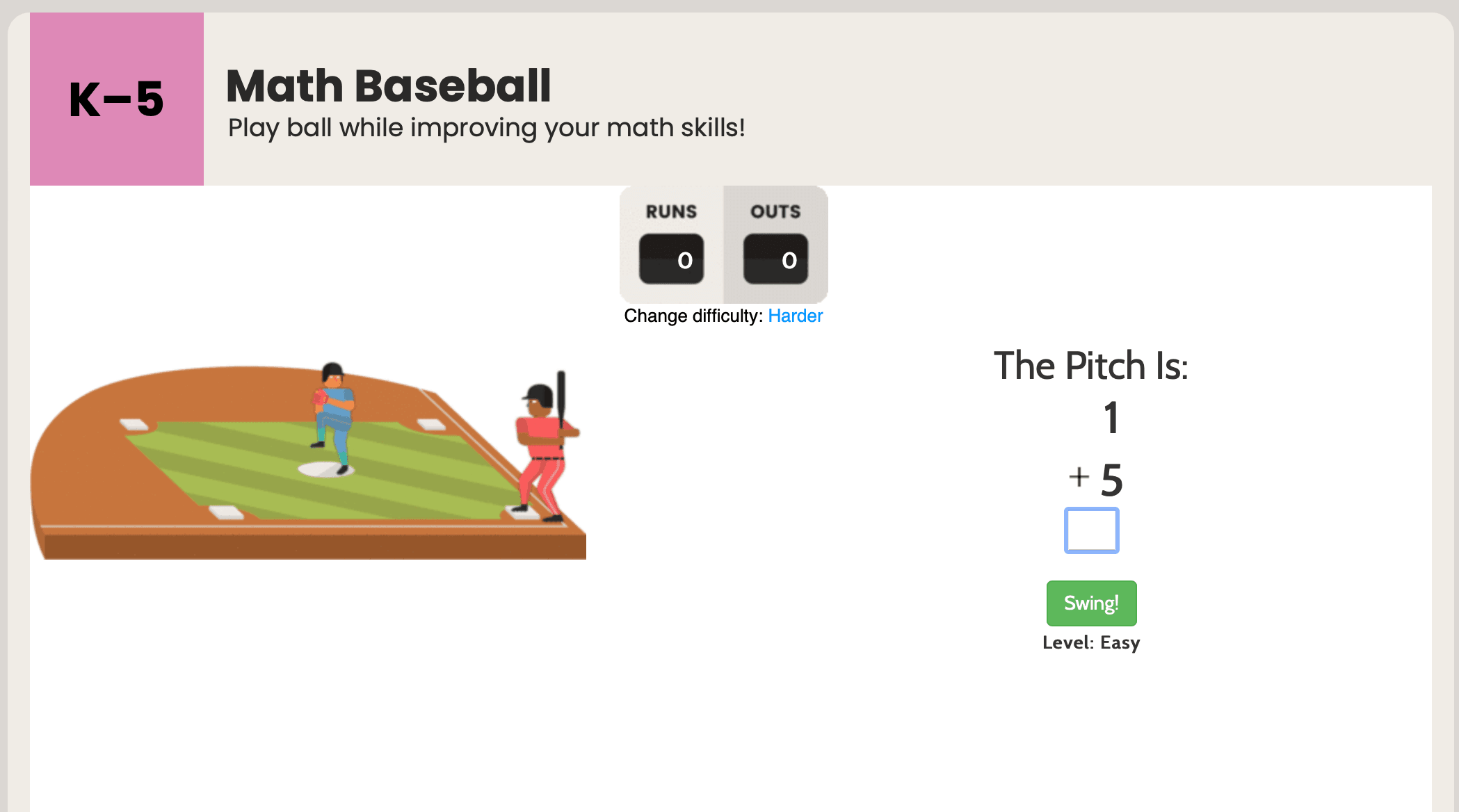
Funbrain is a math resource hub established in 1997. It offers educational games, reading resources, videos, and printables for PreK-8 students.
Major features of Funbrain:
- Free Math Games Online. Funbrain features over 80 versatile maths games with customizable difficulty levels for children of all grades.
- Children can solve math tasks with fun animated characters in different settings.
- Math Videos, Books, and Comics. At Funbrain, children can access dozens of educational videos, books, and comics about nature, science, and math. You can pick the one corresponding to your child’s age and grade from a scrollable resource feed.
- Math Zone. Math Zone is a part of the Funbrain network dedicated to math specifically. It features a collection of high-quality math games for PreK-8 students. Select titles from the scrollable feed – it features both games tied to specific grades and universal activities.
Moose Math
Type: learning math through creative play.
Moose Math is a math app for kindergartners and first-graders that enhances math skills in the following topics: Numbers – the concept of numbers, number words, and counting; Arithmetic operations – addition and subtraction; Geometry – geometric shapes and figures; Measurements – understanding the concept of lengths and their comparisons.
The most popular children’s math games on the Moose Math app:
- Moose Juice. Moose Juice is a cooking game where children help a moose prepare smoothies and cocktails. The game involves measurements, counting, addition, and subtraction aspects.
- Pet Bingo. Pet Bingo allows children to solve math problems to open pets that match winning combinations.
- Lost & Found. Children can practice their geometry skills by finding, categorizing, and sorting geometric figures.
- A City of Pets. Completing different levels of Moose Math games, children unlock items and pets to build their city with fantasy creatures.
- Student Performance Control. Moose Math provides detailed reports on your student’s performance based on game-level completion and involved math skills.
Khan Academy
Type: educational technology and apps.
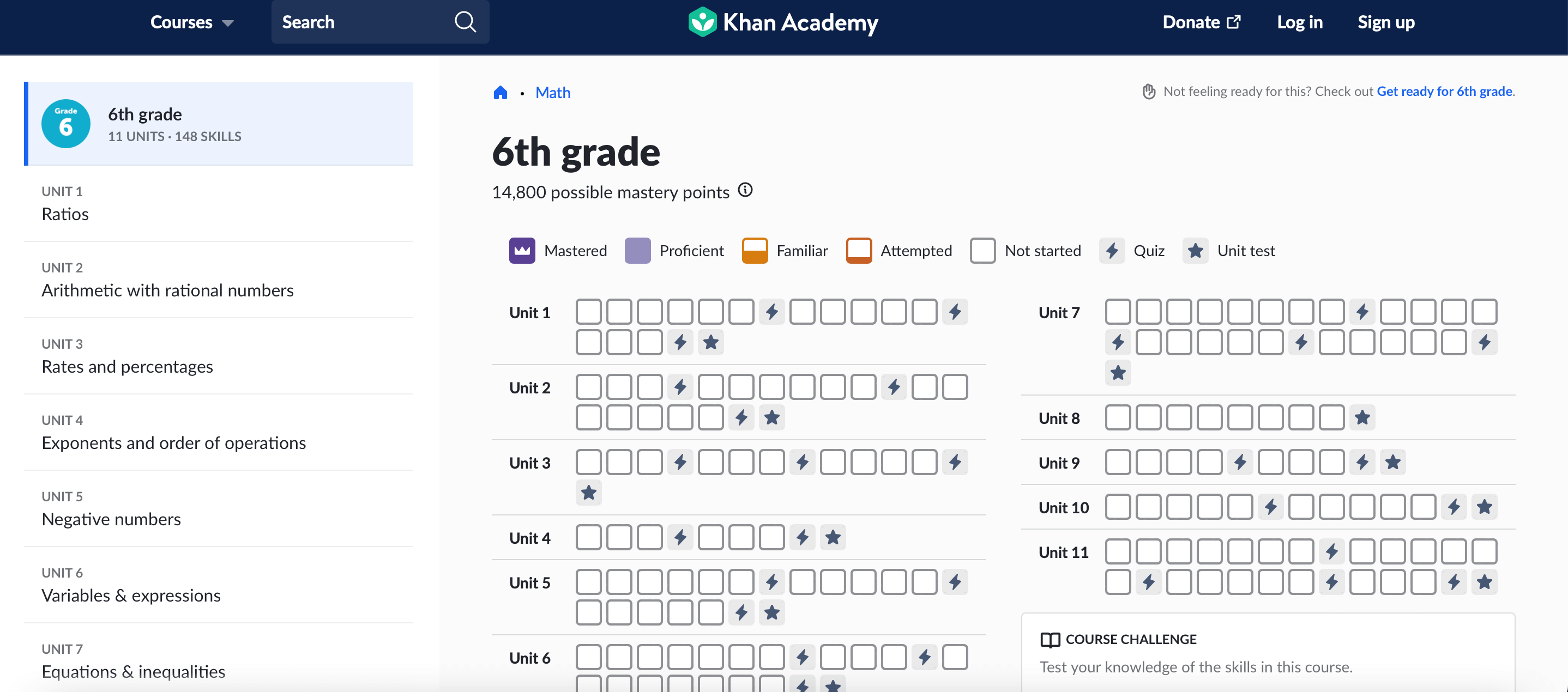
So, the next place you can find math games for kids for free is Khan Academy. This platform provides a wide range of mathematical courses from Pre-K to High School.
Major features of Khan Academy:
Here, you’ll find valuable content and activities for your child, such as games and watching helpful videos.
The platform can help you make math an easier subject for your child to learn. All of this is more than possible with Khan Academy’s interactive math tasks and interesting and fun games.
Note. Besides games and content to uplevel math scores, you can use this platform with your child to improve scores in biology, history, language learning, and more.
Prodigy Math Game
Type: learning math through creative play.
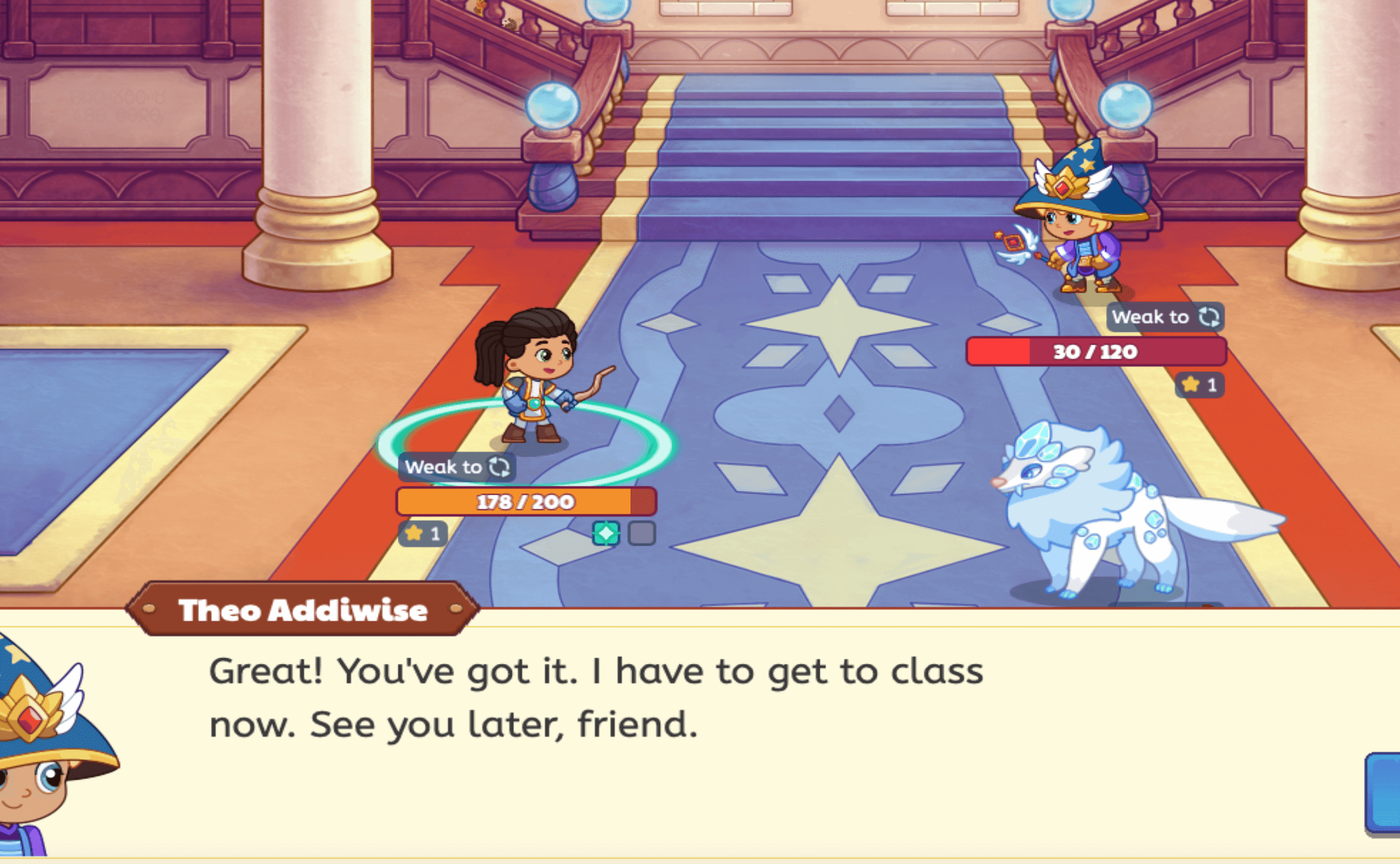
Prodigy Math Game is a platform that offers math and English learning through interactive games. It will be efficient for children from 1st grade to 8th grade.
Major features of Prodigy Math Game:
- The founders of Prodigy math games online have implemented RPG elements for learning math, making the educational process catching and fun.
- Your child will be excited about the fact that the game offers daily prizes, exclusive items, and the ability to customize the character.
- Choose your child’s grade and be sure that they practice math in an app that is aligned with your child’s curriculum.
Cool Math Games
Type: classic math-based games.
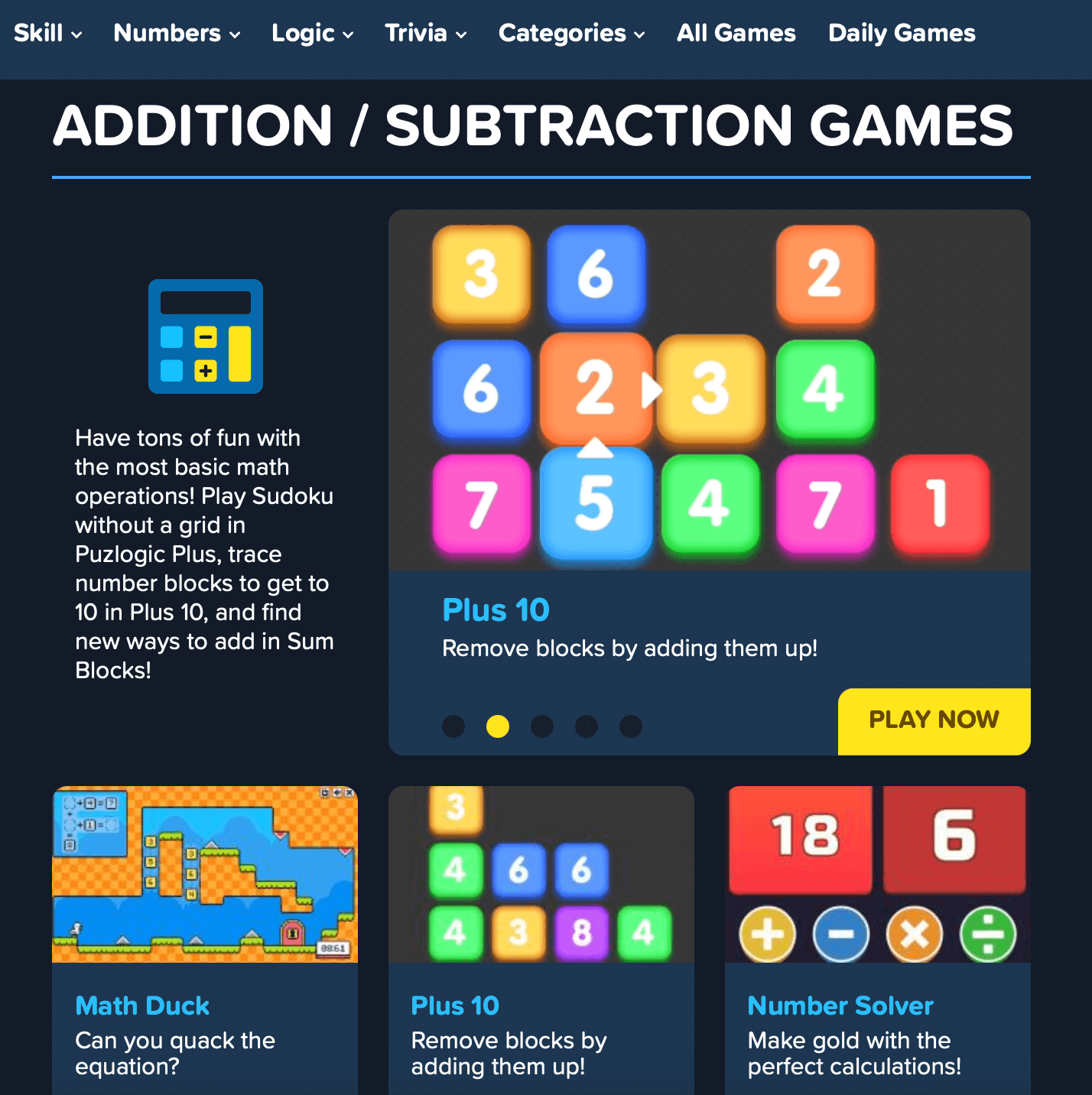
Cool Math Games is an educational platform with different math games. These activities are designed to help your child improve logical thinking and strategic skills.
Major features of Cool Math Games:
- Get thousands of strategic, logic, and math games that engage your child from the first seconds.
- According to the Cool Math Games website, each game on the platform is designed to be not only fun for children but also to help them succeed in their studies and inspire them to enjoy learning math.
ABCya
Type: learning math through creative play.
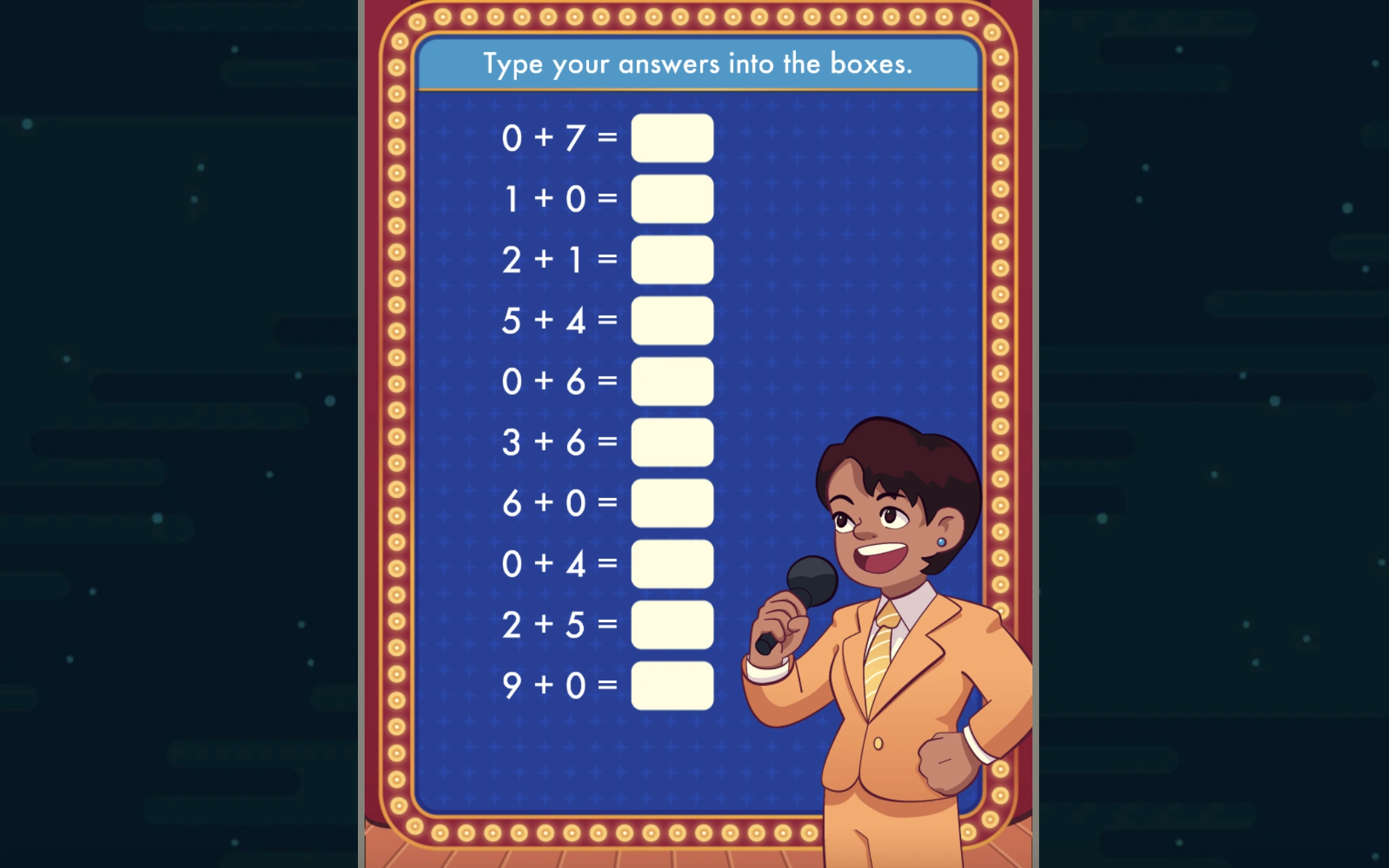
ABCya is a platform with 300 various educational games to enhance knowledge of some school academic subjects. In addition, here, you can find the best math games for children, which aim to improve children’s math knowledge from Pre-K to 6+ grade.
Major features one of the top games on ABCya – Math Quiz:
- Math Quiz allows children to practice various mathematical operations such as addition, subtraction, multiplication, and division.
- The game includes quizzes with different levels of complexity. Math Quiz is suitable for pupils of different ages and grade levels (from 1 to 6+ grade).
- Here, you can print your child’s results for each successfully completed level.
Arcademics
Type: math strategies and problem-solving.
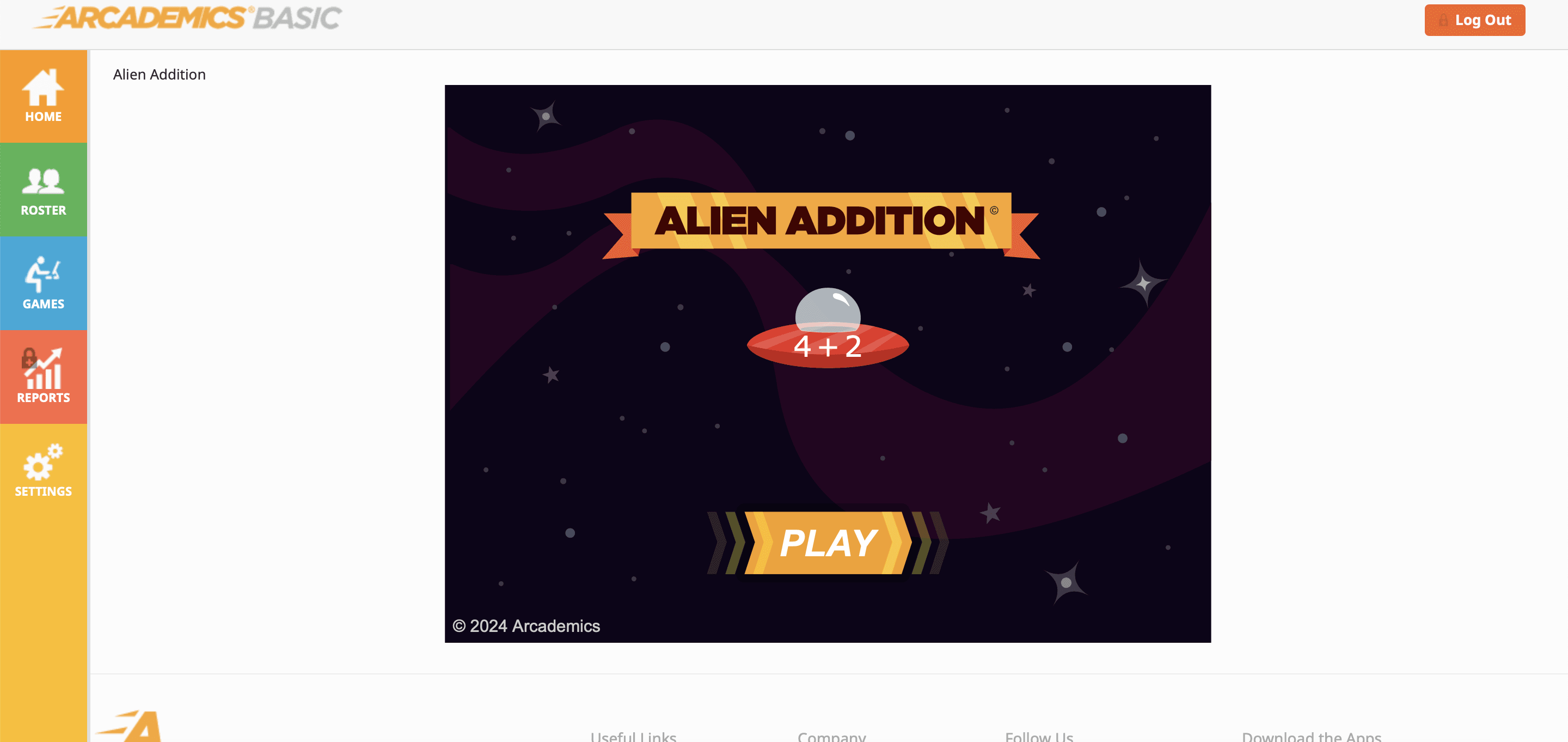
Arcademics is a platform with math games for kids for free (1st to 6th grade). There are also educational video games for language arts and vocabulary. The website is filled with games that combine arcade styles with math exercises to help kids learn quickly and effectively.
Major features of Arcademics:
- It is possible to use educational games in the classroom because several children can play at once. This can help improve teamwork, too.
- Arcademics games help children learn the material better, as this format arouses their genuine interest.
- Does your child love video games? Then, you can choose Arcademics and combine an activity that is interesting to your child with something useful for their learning. It’s a great way to enjoy the game and practice math skills at the same time.
If you search for more math apps and websites, check Brighterly’s list of educational platforms for kids.
Best Math Games for Kids to play in the class or outdoors
- Math Tic-Tac-Toe
- Multiplication Touch
- Math Baseball
- Math Facts Race
- Around the Block
- Math Twister
- The Number Line Run
- The Frisbee 500 Game
- Ping Pong Throwing
- The Water Balloons Game
More about 10 kid math games for playing in the classroom and outdoors read below.
Math Tic-Tac-Toe
Type: classic math-based games.
Tic-Tac-Toe is a fun game for two players, and you can make it more challenging with math.
How to play Tic-Tac-Toe?
It requires:
- 3×3 grid sheets.
- Nine tokens numbered 1-9 for each player. The tokens should differ in color to represent team colors.
Two players should use three tokens to make a total of 15, filling a row on the grid. The player wins if they make it first.
Multiplication Touch
Type: learning math through creative play.
Multiplication Touch is one of the most fun math games for kids that you can use as an alternative to traditional math flashcards.
This game includes a custom-made playboard designed as a multiplication grid and numbered cardboard tiles. Check how to set up the Multiplication Touch below.
How to play multiplication touch?
Players should follow these rules:
- As a referee, place all numbered tiles face down.
- At the start, the two players draw ten tiles each.
- The players draw tiles and place them in the matching cells on the multiplication mat. To do so, they need to solve the associated multiplication problems.
- Players have to put tiles so that they touch each other.
- The player wins if they are the first to put all tiles on the multiplication grid.
Setting up multiplication touch playboard
First, you need a playboard mat. Follow these steps to make one:
- Get a 10×10-inch piece of cloth – it can be a mat or a kitchen towel.
- Get a waterproof marker, or better, a cloth dye.
- Get a ruler.
- Draw a 10×10 multiplication grid on the mat and leave free space on the left and top sides.
It’s time for tiles once you complete the mat:
- Cut 100 cardboard tiles and number them from 1 to 100.
- Get two more 1-10 sets of tiles to label your multiplication grid.
- Cut up to four blank tiles.
Math Baseball
Type: math games based on sports & physical activity.
Math Baseball is a simple and one of the best math games for kids that can be prepared in a few minutes.
Preparation for a game of Math baseball:
For this, you need:
- Come up with math problems (simple, moderate, and difficult).
- Decide which topic you will practice and write these math problems on paper sheets.
- Make sure your students answer these problems in their minds within 5-10 seconds.
- Then, write these math problems on the paper sheets with answers on the backside (optional). Aim for 16-20 math problems.
- Sort these equations by difficulty. For example, 5 + 4 goes to simple, 16 + 22 goes to moderate, and 254 + 328 goes to difficult.
These complexity levels will match single, double, or triple pitches. Simple and difficult problems will cost fewer and more points, respectively.
How to play Math Baseball?
- Draw a baseball field on the chalkboard and create sections to write team points.
- Divide your class into two teams and ask them to stand in a line (a batting order).
- A pitcher will choose a math problem – single, double, or triple. If they answer correctly, the team gets the points.
- If the pitcher gives the wrong answer three times, they get disqualified.
Math Facts Race
Type: learning math through creative play.
Math Facts Race is a fun in-class activity, math game, for K-3 students, and it doesn’t require anything except a few grid sheets.
Preparation for a game of Math baseball:
First, divide your class into two teams. Give each of them a grid sheet.
Once you declare math problems (these can refer to addition or multiplication), kids should race to the chalkboard.
How to play the math game?
Kids should write numbers in the math grid to reflect the intersections of rows and columns.
For instance, if you declare 5 + 3, a kid goes to the blackboard and fills the cell where column 5 and row 3 intersect.
This exercise allows kids to visualize math equations, practice speed calculations, and improve focus.
Children should carefully watch their teammates solve equations. If anyone makes an error, one of their teammates should use their turn to correct it.
The team wins if they fill all cells on their math grid first.
Around the Block
Type: outdoor and adventure math games.
Around the Block is a fun, low-budget in-class activity that requires only a ball to practice math skills. Activities like these math games for children have incredible benefits, such as being able to be done outside and teamwork.
Here is how it works:
- First, ask your kids to sit in a circle. You start a game as a referee by passing a ball to a student.
- Then, you say a math problem, and they need to solve it. When a student answers the problem correctly, they choose another student to pass the ball.
- If a student gets the wrong answer, you choose the next student to solve it. If they answer correctly, they decide where the ball goes next.
For more classroom math games and activities, explore our comprehensive list.
Math Twister
Type: Classic math-based games.
Twister is a fun outdoor game you can modify to study math.
Preparation of a math game
Prepare sticky notes corresponding to Twister mat circles. Write numbers on the sticky notes – these will answer math problems. For more convenience, you can prepare math problems on a separate list – it will be yours.
How to play?
You are a referee, and you will be the one to spin the spinner and watch your kids clumping on the mat.
Once the spinner stops, you announce it: «left hand, 5+3». The player wins if they are the most agile and fast-calculating.
Why is the Math Twister math game good for your children?
Math Twister is unarguably fun, and it helps children to: improve computational accuracy in stressful circumstances (it’s a positive adrenaline rush), calculate numbers in their minds, and be more agile.
The Number Line Run
Type: Math strategies & problem-solving.
Little kids love running, and it’s an excellent chance to use their passion for the sake of math. Your child can practice counting and addition by playing a number line run.
How to play such learning math games for kids?
You need a set of crayons or just a single one for this game:
- Draw a line on the sidewalk – it’s desirable if you make it as long as possible. Let it be 20 feet long.
- Mark it with numbers from 0 to 20, 25, 30, 35, and 40 – it’s up to you.
- Start the race. Say a number and ask a child to run and stop at its mark on the sidewalk line.
Number line jump
If your kid is bored with running across the number line, suggest jumping. They will learn to count by jumping until the required number.
You can let them practice skip counting – jumping by two or three. You can also measure jump length. There is plenty of space for math game modification.
The Frisbee 500 Game
Type: Math games based on sports & physical activity.
Frisbee is an active game that requires two players. It doesn’t require exceptional athletic skills. Plus, your children can practice math while throwing frisbee without even realizing it.
The game rules
The game rules are simple:
- There are 500 points in total.
- Each throw counts as 10/20/25 points – it’s up to you.
- If a player catches the Frisbee, they get the points. If not, they don’t get any points for the throw.
- The player wins if they collect 500 points first.
How to play such learning math games for kids?
To play the game, you need a Frisbee and two crayons.
- Two players stand at least five feet in front of each other.
- The players throw the Frisbee at each other.
- The player gets 10/20/25 points once they catch the Frisbee. If they don’t, they lose the throw.
- Players write their points somewhere next to their stands.
- Repeat until one of you gets 500 points.
This game teaches counting and addition up to 500.
Ping Pong Throwing
Type: Math games based on sports & physical activity.
You can modify a ping pong game to make it a simple math practice.
Preparation of a math game
- Get ten cups (you can buy plastic ones) and place them in a row.
- Get ten pieces of cardboard or paper and number them – there will be answers to math problems.
- Then, you speak out a math task, and children have to throw a ping pong ball into the correct cup.
- For this game, you need: ten cups, a marker, ten square pieces of paper, a ping pong ball, and transparent duct tape.
Game modifications
If you want something more active, you can modify this game a little – draw circles on the playground or a wall and put numbers there. Kids will throw the ball against the wall or in circles on the pavement.
Benefits of the Ping Pong Throwing math game
It’s a simple game that encourages children to count numbers and solve simple math equations in their minds. Kids also improve motor and spatial skills while throwing the ball.
You can easily modify the game by adjusting it to addition, subtraction, multiplication, and division tasks. Or, you can tailor it to decimals or measurements – it’s up to you.
The Water Balloons Game
Type: Outdoor and adventure math games.
And The Water Balloons Game closes our top game. This is a fun game that includes a bit of physical activity.
How to play?
- To play this game, you need chalk, markers, and up to ten water-filled balloons.
- Fill the balloons with water and number them – choose whatever numbers you want.
- Then, make math problems to these numbers become answers.
- Draw math equations on the floor and circle them.
- Then, ask children to throw the balloons at the appropriate equations.
If you want to find more outdoor fun math games and activities, check out our comprehensive selection.
Conclusion
Online math learning can become more exciting if you involve math game websites, online math games for kids, and classroom or outdoor activities. Children can practice essential math skills by playing fun games and enjoying the process.
Brighterly has advanced even further by implementing entertaining activities into the math curriculum. At Brighterly, tutors keep things perfectly balanced – math theory lessons follow fun games that shift into assessment classes, and so on.
If your child needs to work on math better, you can enroll them in Brighterly’s math courses. By learning math in 1-to-1 classes, children will enjoy practicing and developing numerical fluency.




